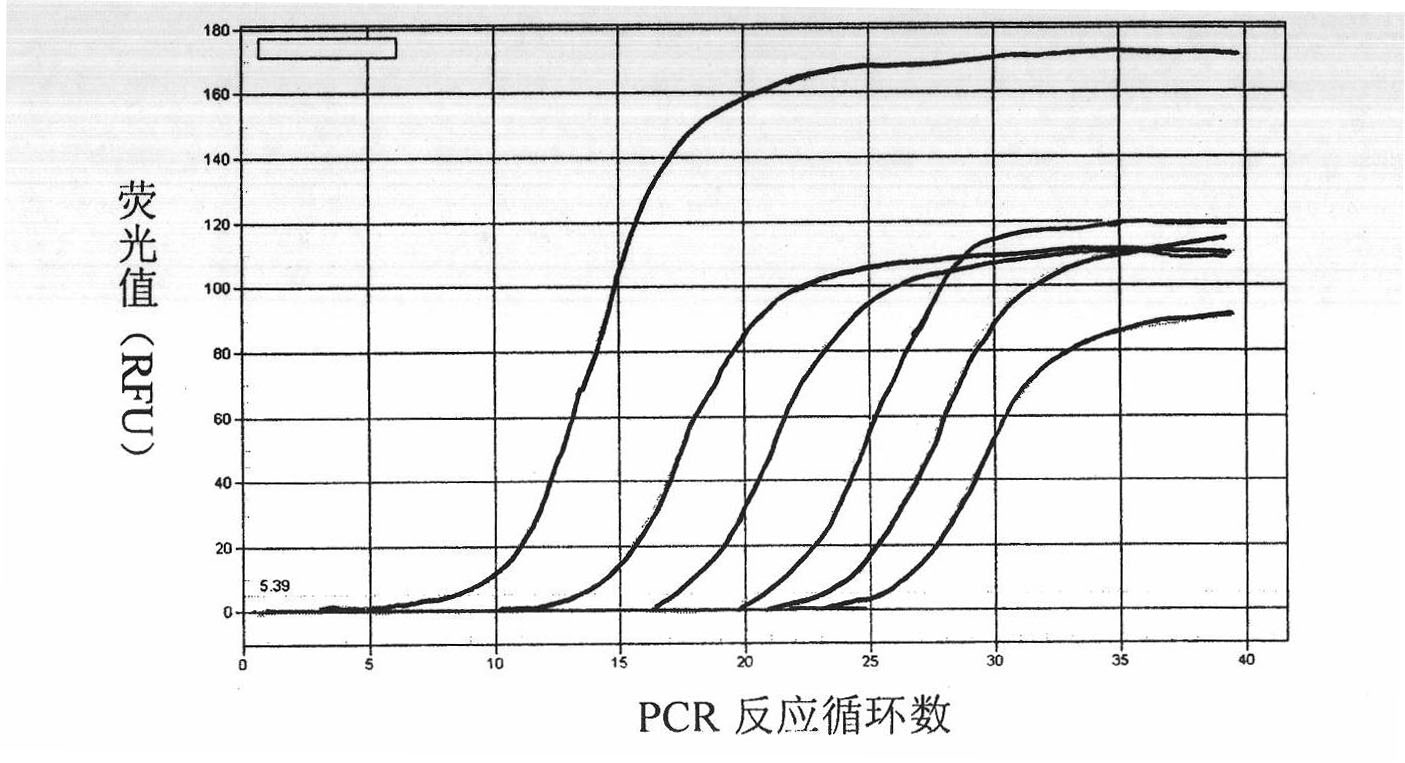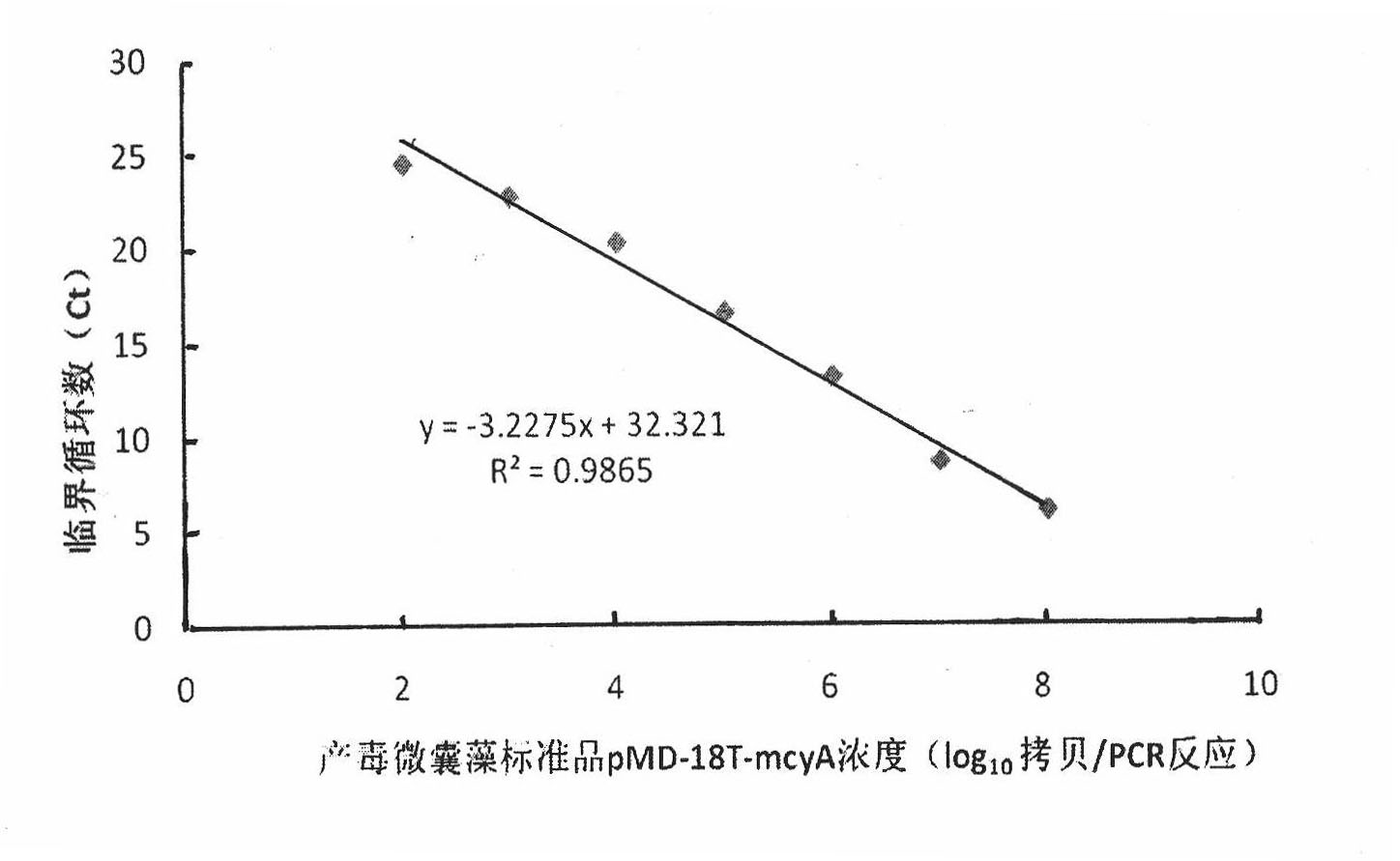Method for quantitatively detecting toxigenic microcystis and special standard substance thereof
A technology of microcystin and standard products, which is applied in biochemical equipment and methods, measurement/inspection of microorganisms, introduction of foreign genetic material using carriers, etc., can solve the problems that microcystins cannot meet early warning and water quality safety control, etc. Achieve the effects of wide linear detection range, good purity, and simple preparation method
- Summary
- Abstract
- Description
- Claims
- Application Information
AI Technical Summary
Problems solved by technology
Method used
Image
Examples
Embodiment 1
[0036] Embodiment 1, preparation of the standard product pMD-18T-mcyA plasmid standard product of quantitative detection Microcystis
[0037] 1. Culture of Microcystis aeruginosa
[0038] The toxin-producing strain Microcystis aeruginosa (Microcystis aeruginosa) numbered FACHB-905 was purchased from Wuhan Institute of Hydrobiology, Chinese Academy of Sciences. Microcystis aeruginosa was cultured according to the culture method provided by the Institute of Hydrobiology, Chinese Academy of Sciences. Prepare BG11 medium according to the provided formula (Table 1), that is, in 1000mL deionized water, add the following substances respectively, and store at 4°C after sterilization.
[0039] Table 1BG11 medium formula
[0040]
[0041]
[0042] For the cultivation of algae, avoid inoculating a small amount of algae in a large amount of medium. The entire process of cultivating algae requires absolute aseptic operation, and the experimental tools required for cultivation and ...
Embodiment 2
[0125] Embodiment 2, establishment of Microcystis quantitative PCR detection method
[0126] 1. Optimization of quantitative PCR reaction conditions
[0127] The DNA of Microcystis aeruginosa (number FACHB-905) (toxin-producing strain) was extracted using the method in Example 1. according to Premix Ex Taq TM (Code: DRR041S) manual, the reaction system of qPCR is (20μL): Premix Ex Taq TM 10 μL, 0.1-0.5 μL each of the upstream and downstream primers (mcyA-F, mcyA-R) (final concentration 0.1-0.5 μmol / L), the Microcystis aeruginosa obtained above (number FACHB-905) (toxin-producing strain ) DNA 2 μL, double distilled water 7.6 μL to make up the volume to 20 μL.
[0128] The qPCR reaction procedure is as follows, 1 cycle: 95°C, 5min; 40 cycles: 95°C, 5s, 50-60°C, 30s, 72°C, 30s, fluorescence is collected during annealing; the process of the melting curve is: 95°C , 1min, 1min at 65°C, the temperature rises by 0.5°C every 30s starting from 65°C, and the junction temperatur...
Embodiment 3
[0152] Embodiment 3, utilize quantitative PCR method to detect Microcystis in actual water environment sample
[0153] 1. Actual water sample collection
[0154] The actual water samples were taken from Taihu Lake and its surrounding rivers, and the sampling time was August 10-11, 2010. The sampling method shall be taken at 0.5m below the water surface according to the standard sampling method. The samples were transported back to the laboratory in an ice box and stored at 4°C.
[0155] 2. Determination of chlorophyll a and algae density
[0156] August is the season for cyanobacteria blooms in the Taihu Lake Basin. The instrument YSI6600V2 was used to detect the algae density and chlorophyll a of the water samples. The results are shown in Table 5. The concentration of chlorophyll a is 1.7×10 -3 -1.35×10 -2 mg / L, the density of algae is 8.2×10 5 -2.4×10 7 a / L. (Chlorophyll-a and algae density are routine indicators of water eutrophication.)
[0157] Table 5 Chlorophyl...
PUM
| Property | Measurement | Unit |
|---|---|---|
| melting point | aaaaa | aaaaa |
Abstract
Description
Claims
Application Information
 Login to View More
Login to View More - R&D
- Intellectual Property
- Life Sciences
- Materials
- Tech Scout
- Unparalleled Data Quality
- Higher Quality Content
- 60% Fewer Hallucinations
Browse by: Latest US Patents, China's latest patents, Technical Efficacy Thesaurus, Application Domain, Technology Topic, Popular Technical Reports.
© 2025 PatSnap. All rights reserved.Legal|Privacy policy|Modern Slavery Act Transparency Statement|Sitemap|About US| Contact US: help@patsnap.com



